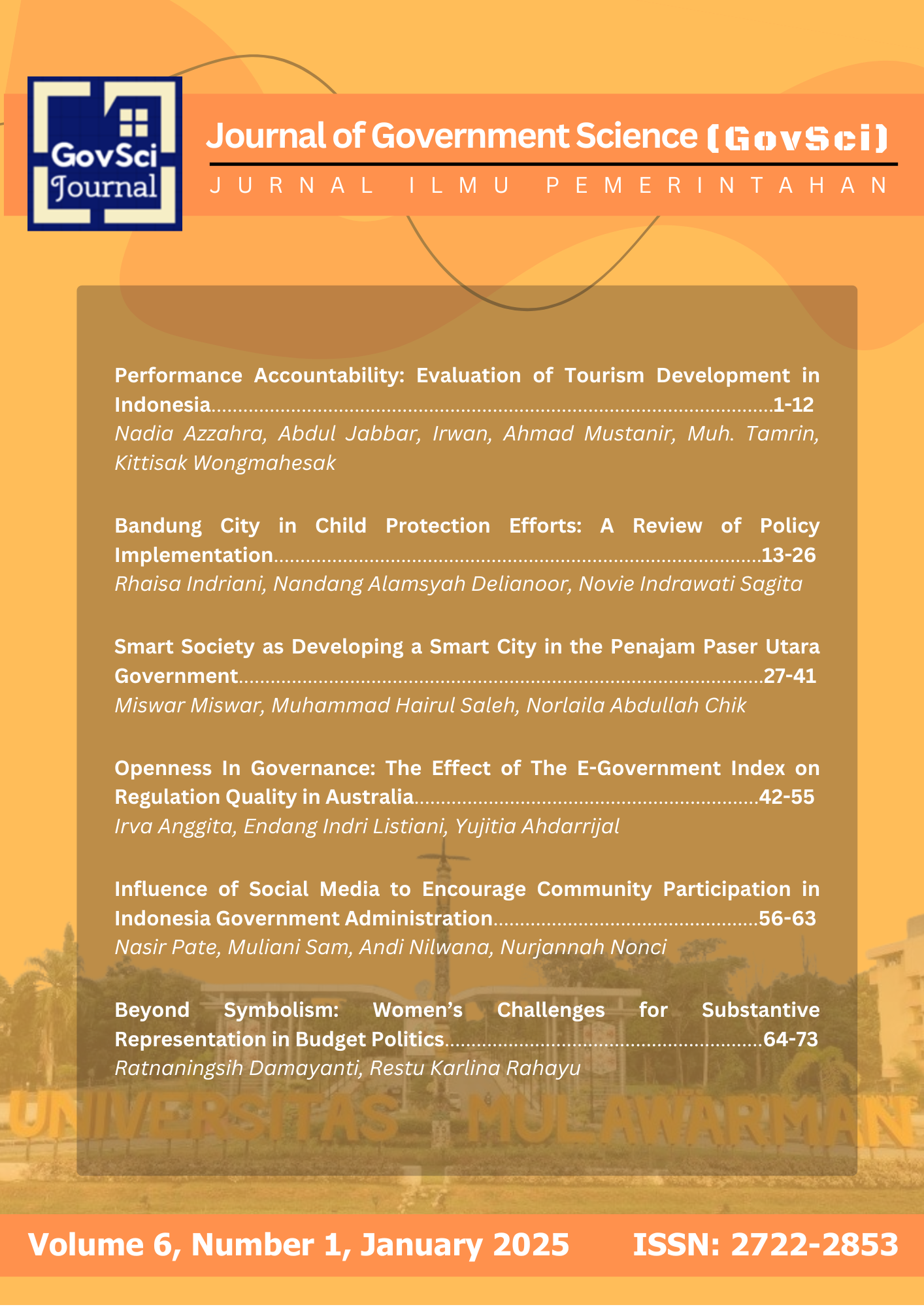Beyond Symbolism: Women’s Challenges for Substantive Representation in Budget Politics
Abstract
The presence of women in legislative institutions represents a form of symbolic representation obtained through general elections. Generally, there is an expectation from the public, particularly voters, that through the presence of women in legislative institutions, female legislators will focus more on issues that impact women. This research is an extension of previous studies on women in politics, where the focus has often been on the process of women entering political institutions. This study examines women's involvement in the budgeting process in Batu City, East Java. The research method used is qualitative research. Data was collected from document analysis, observation, and interviews with female DPRD (Regional Representative Council) members and local government bureaucrats. The findings show that the executive uses a technocratic approach to control the regional budgeting process. The budgetary board discusses the budget draft with the attending legislative members in the legislative branch. The budgeting procedure limits the participation of women legislative members in the budget committee. The participation of female DPRD members in budgeting is hindered by the dominance of political parties and the patriarchal culture within political parties. Not all female DPRD members on the budgetary board can be involved in the budgeting process; only senior politicians can join the budget committee. Thus, at the regional level, the representation of women in the DPRD is still in the category of symbolic representation.
References
Asiedu, E., Branstette, C., Gaekwad-Babulal, N., & Malokele, N. (2018). The Effect Of Women’s Representation In Parliament And The Passing Of Gender Sensitive Policies.
Aspinall, E., White, S., & Savirani, A. (2021). Representation In Indonesia: Who Wins And How? Journal Of Current Southeast Asian Affairs, 40(1), 3–27.
Atkinson, M. L., & Windett, J. H. (2019). Gender Stereotypes And The Policy Priorities Of Women In Congress. Political Behavior, 41(3), 769–789. Https://Doi.Org/10.1007/S11109-018-9471-7
BPS Batu Municipality. (2020). Batu Municipality In Figures 2020.
Clayton, A. (2021). How Do Electoral Gender Quotas Affect Policy? Https://Doi.Org/10.1146/Annurev-Polisci-041719
Clayton, A., Josefsson, C., & Wang, V. (2017). Quotas And Women’s Substantive Representation: Evidence From A Content Analysis Of Ugandan Plenary Debates. Politics And Gender, 13(2), 276–304. Https://Doi.Org/10.1017/S1743923X16000453
Creswell, W.J. And Creswell, J. D. (2018). Research Design: Qualitative, Quantitative, And Mixed Methods Approaches, Journal Of Chemical Information And Modeling.
Devlin, C., & Elgie, R. (2008). The Effect Of Increased Women’s Representation In Parliament: The Case Of Rwanda. Parliamentary Affairs, 61(2), 237–254. Https://Doi.Org/10.1093/Pa/Gsn007
Dolan, K. (2010). The Impact Of Gender Stereotyped Evaluations On Support For Women Candidates. Political Behavior. Https://Doi.Org/10.1007/S11109-009-9090-4
Earl Babbie. (2008). The Basic Of Social Research (4th Ed.). Thomson Wadsworth.
Funk, K. D., & Philips, A. Q. (2019). Representative Budgeting: Women Mayors And The Composition Of Spending In Local Governments. Political Research Quarterly, 72(1), 19–33. Https://Doi.Org/10.1177/1065912918775237
Gay, L.R., Mills, G.E. And Airasian, P. (2006). Educational Research: Competencies For Analysis And Application. Prentice-Hall.
Hendrarto. (2019). Peran Perempuan Dalam Politik Di Era Demokrasi. Jurnal Komunikasi Dan Kajian Media, 3(156–69).
Indraswari. (2008). Perempuan, Kemiskinan, Dan Anggaran Pembangunan. Jurnal Administrasi Publik, 5(2), 252–269. Https://Journal.Unpar.Ac.Id/Index.Php/JAP/Article/View/1571
Kiftiyah, A. (2019). Perempuan Dalam Partisipasi Politik Di Indonesia. Jurnal Yuridis, 6(2), 55–72.
Lawless, J. L. (2004). Women, War, And Winning Elections: Gender Stereotyping In The Post-September 11th Era. In Political Research Quarterly. Https://Doi.Org/10.1177/106591290405700312
Lienert, I. (2005). Who Controls The Budget: The Legislature Or The Executive? IMF Working Papers, 05(115), 1. Https://Doi.Org/10.5089/9781451861341.001
Mansbridge, J. (2005). Quota Problem: Combating The Dangers Of Essentialism. Politics And Gender, 1(4), 622–638. Https://Doi.Org/10.1017/S1743923X05230192
Mechkova, V. (2021). Women Leaders: Exploring The Effects Of The Chief Executive Gender On Budget Composition In Comparative Perspective. In SSRN Electronic Journal (Issue 46). Https://Doi.Org/10.2139/Ssrn.3947097
Melusky, B. (2020). Gender And Fiscal Gridlock In The American States. Journal Of Women, Politics, And Policy, 41(3), 249–277. Https://Doi.Org/10.1080/1554477X.2019.1663097
Moser, B., & Korac, S. (2021). Introducing Gender Perspectives In The Budgetary Process At The Central Government Level. International Journal Of Public Administration, 44(14), 1274–1285. Https://Doi.Org/10.1080/01900692.2020.1755683
Mueller, S. (2024). Assessing The Role Of Gender-Related Aspects In Public Budgeting Debates: A View Of The Central Level In Germany. International Review Of Administrative Sciences, 90(1), 167–184. Https://Doi.Org/10.1177/00208523231156538
Nurhaeni, I., & Habsari, S. (2011). Efektivitas Implementasi Kebijakan Anggaran Responsif Gender. JIANA (Jurnal Ilmu Administrasi Negara), 11(1), 74–86. Http://Ejournal.Unri.Ac.Id/Index.Php/JIANA/Article/View/1073
O’Brien, D. Z., & Piscopo, J. M. (2019). The Impact Of Women In Parliament. In Gender And Politics (Pp. 53–72). Palgrave Macmillan. Https://Doi.Org/10.1057/978-1-137-59074-9_4
Phillips, A. (1998). The Politics Of Presence. Oxford University Press Oxford. Https://Doi.Org/10.1093/0198294158.001.0001
Priandi, R., & Roisah, K. (2019). Upaya Meningkatkan Partisipasi Politik Perempuan Dalam Pemilihan Umum Di Indonesia. Jurnal Pembangunan Hukum Indonesia, 1(1), 106–116. Https://Doi.Org/Https://Doi.Org/10.14710/Jphi.V1i1.106-116
Rosenwasser, S. M., Rogers, R. R., Fling, S., Silvers-Pickens, K., & Butemeyer, J. (1987). Attitudes Toward Women And Men In Politics: Perceived Male And Female Candidate Competencies And Participant Personality Characteristics. Political Psychology. Https://Doi.Org/10.2307/3791299
Saftiana, Y., Ekonomi, F., & Sriwijaya, U. (2012). AKOMODASI KEPENTINGAN PEREMPUAN. 6(1), 40–53.
Santiso, C. (2007). Understanding The Politic Of Budget. Https://Doi.Org/10.1201/9780429091360-5
Silbermann, R. (2015). Gender Roles, Work-Life Balance, And Running For Office. Quarterly Journal Of Political Science, 10(2), 123–153. Https://Doi.Org/10.1561/100.00014087
Smrek, M. (2022). When Is Access To Political Capital Gendered? Lessons From The Czech Parliament. Parliamentary Affairs, 75(1), 76–93. Https://Doi.Org/10.1093/Pa/Gsaa051
Stanić, B. (2023). Gender (Dis)Balance In Local Government: How Does It Affect Budget Transparency? Economic Research-Ekonomska Istrazivanja, 36(1), 997–1014. Https://Doi.Org/10.1080/1331677X.2022.2081232
Wahyudi, V. (2018). Politea : Jurnal Politik Islam Peran Politik Perempuan Dalam Persfektif Gender Very Wahyudi Pendahuluan Membangun Masyarakat Sipil Berarti Memperjuangkan Ruang Publik Yang Di Dalamnya Mencakup Seluruh Warga Negara Baik Laki- Mengakibatkan Berbagai Kepenti. Politea: Jurnal Politik, 1(1), 63–83.
Widiyaningrum, W. Y. (2020). Partisipasi Politik Kader Perempuan Dalam Bidang Politik: Jisipol, 4(2), 126–142. Https://Ejournal.Unibba.Ac.Id/Index.Php/Jisipol/Article/View/296/253
Wildavsky, A. (1988). The New Politics Of The Budgetary Process. Https://Doi.Org/Https://Doi.Org/10.2307/1962110
Winter, N. J. G. (2010). Masculine Republicans And Feminine Democrats: Gender And Americans’ Explicit And Implicit Images Of The Political Parties. Political Behavior. Https://Doi.Org/10.1007/S11109-010-9131-Z
Authors
Copyright (c) 2025 Ratnaningsih Damayanti

This work is licensed under a Creative Commons Attribution-ShareAlike 4.0 International License.

